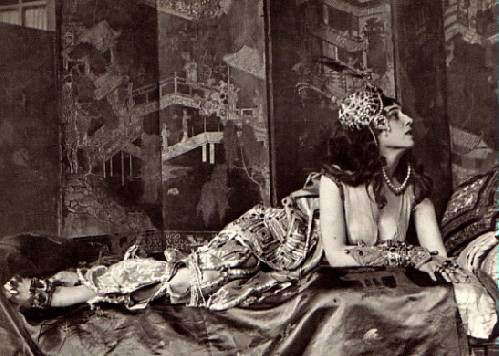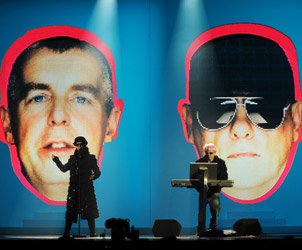Contemporary Dance Weekend, BBC Four | reviews, news & interviews
Contemporary Dance Weekend, BBC Four
Contemporary Dance Weekend, BBC Four
The vain presenter of a flagship doc can't entirely ruin a night's banquet
Yesterday was a day when male physicality and the science of movement preoccupied - when you watch Rafa Nadal or Jo-Wilfried Tsonga, you can’t help thinking about the contrasts of grace that achieve the same athletic needs; Nadal the pouncing cheetah, the rich, weighty speed of Tsonga. Thing is, when you watch programmes about the greatness of tennis, they don’t try to persuade you that it’s just as good to watch if you yourself learn to play and get it filmed for the public's delight.
This false premise has recently taken over the entire contemporary dance world; we must become awful dancers ourselves in order to “understand” it; we must get involved, listen to the wordy pre-match explanations, refuse to ask not to be confused (confusion is good: it allows all spectators to be equal), recognise that to judge something bad is to reflect our own inadequacies.
This appears to have been the rather muddled mission behind the Beeb’s flagship documentary, Dance! The Most Incredible Thing about Contemporary Dance, the centrepiece of its daring decision to blanket this weekend with dance programming. This doc was subheaded as a journey of illumination upon an often misunderstood art form. A sort of Scientology approach, really.
Not least, in the reigning idea that contemporary dance needs vast deluges of verbals to explain any objections away, plus the sight of a celeb from another discipline learning a few basics and telling us how wonderful and reborn he feels. The celeb here was that ubiquitous culture vulture, Charles Hazlewood, who evidently left his critical faculties at home for this programme. Thus he gawped at a bunch of dancers improvising vaguely as he played some Bach, unable to take the next step in our illumination of assessing which attempts seemed better to him - and why that might be. He sat down with Lea Anderson, a long-spent force in dance, and Richard Alston, who did talk thoughtfully about dance and music, but Hazlewood showed no curiosity about the criteria people apply in finding Alston's work either masterful or pedestrian.
Attached to the let’s-all-love-each-other creed that has turned contemporary dance into an official government tool for social integration, Hazlewood dismissed ballet as something making too precise demands and carrying “the weight of history”. Though presumably classically trained as a musician, he was unable to acknowledge for his listening public that ballets like La Sylphide and The Sleeping Beauty (the “weight of history”) were modern dance in their day, and that classical training and vocabulary might be a pretty powerful language. The hip-hop dancer Jonzi D made rather more enlightening and stimulating comparisons between the speedy footwork, posing and stunts of street dance and their rough equivalents in classical ballet. Jonzi knows, as Hazlewood apparently doesn’t, that it takes committed training and fastidious judgment to get your locking and popping better than the next one.
 Hazlewood’s project contrasted tellingly with the neighbouring BBC documentary on Diaghilev and the Ballets Russes, For Art's Sake, made in 2009, where critics such as Alastair Macaulay and Lynn Garafola lucidly explained not only choices, decisions and rejections that Diaghilev made in order to maintain his company’s standards, but also brought to life the implicit understanding that to be truly fresh and new, only the very highest professional excellence would do. And, of course, sex, gallons of it. Those millionaire patronesses who paid Diaghilev’s debts were rewarded with ballets of hedonistic luxury and eroticism, with bodies of fabulous strength, suppleness and beauty doing things that ordinary mortals could not even dream of doing (pictured right, Ida Rubinstein in Sheherazade, 1910). Now that’s what I reckon dance should still be about for the spectator, but you don’t get much of it at the moment, all big bottoms and equal values.
Hazlewood’s project contrasted tellingly with the neighbouring BBC documentary on Diaghilev and the Ballets Russes, For Art's Sake, made in 2009, where critics such as Alastair Macaulay and Lynn Garafola lucidly explained not only choices, decisions and rejections that Diaghilev made in order to maintain his company’s standards, but also brought to life the implicit understanding that to be truly fresh and new, only the very highest professional excellence would do. And, of course, sex, gallons of it. Those millionaire patronesses who paid Diaghilev’s debts were rewarded with ballets of hedonistic luxury and eroticism, with bodies of fabulous strength, suppleness and beauty doing things that ordinary mortals could not even dream of doing (pictured right, Ida Rubinstein in Sheherazade, 1910). Now that’s what I reckon dance should still be about for the spectator, but you don’t get much of it at the moment, all big bottoms and equal values.
We saw some evidence of this in films last night of the full-length Pet Shop Boys “ballet”, The Most Incredible Thing, premiered last spring at Sadler’s Wells, and of three shorter works created in Diaghilev’s honour in 2009. A century ago, Erik Satie was incorporating typewriters into his score for a ballet with dancers inside 3D cardboard constructions (designed by Picasso), and Diaghilev and Stravinsky were scheming to create scandal in their ballets. In the Pet Shop Boys production technology has moved on - there’s video, film, electronic music splicing - but it looks backwards to a Hans Christian Andersen fairytale, and the audience is reassured with familiar instant references.
 The cruel competition of the fairytale is recast as Britain’s Got Talent, with uncooperative performing dogs, sequinned quicksteppers and a man balancing a rock on his head. This cheesy humour sits awkwardly with the incredible magical clock created by Leonardo whose hours each generate happy thoughts by quickfire design ideas - eg, 8 for the notes of the piano scale, 9 for an unborn baby in the womb, 10 for Moses and the dancing commandments, with a nod to Busby Berkeley.
The cruel competition of the fairytale is recast as Britain’s Got Talent, with uncooperative performing dogs, sequinned quicksteppers and a man balancing a rock on his head. This cheesy humour sits awkwardly with the incredible magical clock created by Leonardo whose hours each generate happy thoughts by quickfire design ideas - eg, 8 for the notes of the piano scale, 9 for an unborn baby in the womb, 10 for Moses and the dancing commandments, with a nod to Busby Berkeley.
I quite liked the show at its premiere, and the filming (by Ross MacGibbon) highlights that Katrina Lindsay's designs and Lucy Carter's lighting are stars of the show. Neil Tennant and Chris Lowe's tuneful pop music elicits choreography from Javier de Frutos that is, by his standards, too domestic and shorn of its usual effective brutality. This is the guy whose scabrous satire of a perverted pope was dropped by Sadler’s Wells for the BBC filming of the theatre’s 2009 Diaghilev tribute evening, also broadcast last night. The three other ballets, by Sidi Larbi Cherkaoui, Russell Maliphant and Wayne McGregor, had no breath of offensiveness in them, and plenty of camera-friendly, tasteful lyricism in low light.
Overall, if someone had sat down to consume the evening’s entire multi-course banquet, they would have had a rich meal to digest, and I'd guess a taste for more. So on those grounds the Beeb did well. The contrasts between the values of different eras - between, say, Marie Rambert’s natural assumption of her listeners’ intelligence and the vacuity of Hazlewood - were illuminating, not just about how the exclusiveness and mystique that were so prized then have been substituted by today's requirement to exclude no one at all from dance. Somewhere in the past century, the idea that a spectator might just want to sit in the dark watching and wondering at the unbelievable, the impossible and the inexplicable got mislaid.
- Watch these programmes again tomorrow on BBC Four and on BBC iPlayer
- See what's on at Sadler's Wells. Read Sadler's Wells show reviews
- Read theartsdesk Q&A with Javier de Frutos

Comments
...
...
...
...